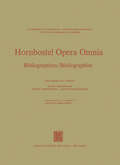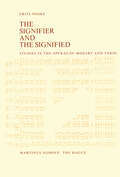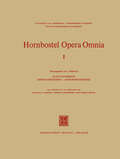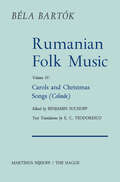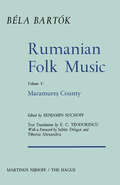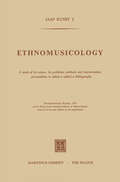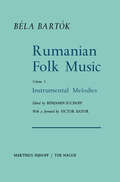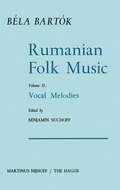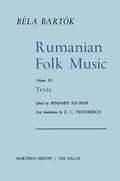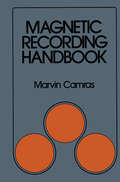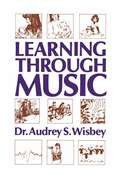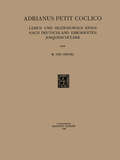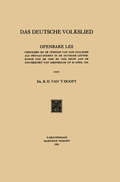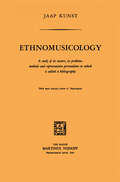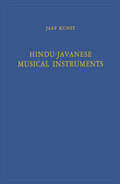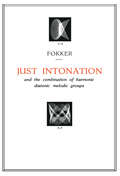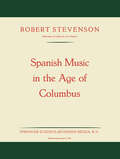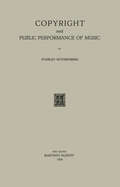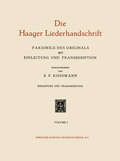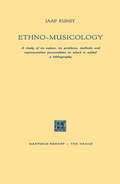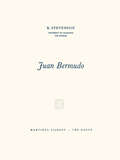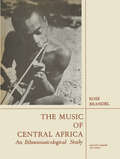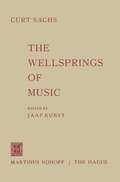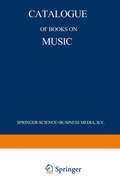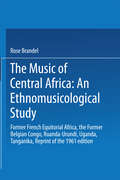- Table View
- List View
Hornbostel Opera Omnia: Bibliographien / Bibliographies (Hornborstel Opera Omnia #2)
by K. P. Wachsmann D. Christensen H. P. ReineckeThe Signifier and the Signified: Studies in the Operas of Mozart and Verdi
by F. NoskeThe studies collected in this volume deal with the interpretation of opera. In most cases the results are based on structural analysis, a concept which may require some clarification in this context. During the past de cade 'structure' and 'structural' have become particularly fashionable terms lacking exact denotation and used for the most divergent purposes. As employed here, structural analysis is concerned with such concepts as 'relationship', 'coherence' and 'continuity', more or less in contrast to formal analysis which deals with measurable material. In other words, I have analysed the structure of an opera by seeking and examining factors in the musico-dramatic process, whereas analysts of form are generally preoccupied with the study of elements contained in the musical object. Though admittedly artificial, the dichotomy of form and structure may elucidate the present situation with regard to the study of opera. Today, nearly one hundred years after the death of Wagner, the proclaimed anti thesis of Oper und Drama is generally taken for what it really was: a means to propagate the philosophy of its inventor. The conception of opera (whether 'continuous' or composed of 'numbers') as a special form of drama is no longer contested. Nevertheless musical scholarship has failed to draw the consequences from this view and few scholars realize the need to study general theory of drama and more specifically the dramatic experience.
Hornbostel Opera Omnia (Hornborstel Opera Omnia #1)
by K. P. Wachsmann D. Christensen H. P. ReineckeRumanian Folk Music: Carols and Christmas Songs (Colinde) (Bartok Archives Studies in Musicology #4)
by Bela Bartokn the first volume of Rumanian Folk Music (Instrumental Melodies) I portions of Bela Bart6k's subsequently-discarded preface, concern ing the fate of his folklore publications, are presented in explanation of the editorial processes necessary for achieving the publication. 1 By way of introduction to this revised edition of a previous, although in complete, published version of the Rumanian Carols and Christmas Songs (Colinde), we refer again to the author's suppressed lines which pertain to this volume: The second publication by the same publisher was to include my collection of Rumanian Colindas (Winter-solstice songs). Their extremely interesting texts were supposed to appear in original as well as in English. After several years of delay, the translation to English prose was completed, one part in adequate archaic English, the rest (by someone else) in most unsuitable Kitchen-English. The publisher did not wish to change this, though. Result: I published the book at my own expense; however, only the musical part, because of lack of sufficient funds. The texts are still in manuscript, even today. 2 Our primary aim, therefore, has been to unite the Rumanian poetic texts and translations with the musical part, in one volume, as was the desire of the author.
Ethnomusicology: A study of its nature, its problems, methods and representative personalities to which is added a bibliography
by E.D KunstThis booklet hardly needs a preface; the contents, I think. speak for themselves.It contains a short and carefully brought up to date resume of all that I. as a private University Lecturer in Amsterdam. have tried to teach my pupils. It is intended as a general introduction to ethnomusicology, before going on to the study of the forms of separate music-cultures. I sincerely hope that those, who wish to teach themselves and to qualify in this branch of knowledge, will find a satisfactory basis for selftuition in the matter here brought together. Regarding the possibility of a new edition, any critical remarks or infor mation as to possible desiderata would be very gratefully received. J.K. PREFACE TO THE SECOND EDITION My request for critical remarks and desiderata has not been ignored. My sincere thanks to all who took the trouble to let me know what they missed in my booklet. Through their collaboration the contents have undergone a considerable improvement and enlargement as compared to the original edition issued in 1950 by the Royal Tropical Institute, Amsterdam. under the title 'Musicologica'. I have taken care to add many particulars from non-European sources. with the result that now the book is no longer so Europe-centric as it was. Furthermore, I have done my best to mention in a special bibliography all the more important ethnomusicological publications, with the exception of those issued in the Russian, Arabic. Chinese, Indonesian, Javanese.
Rumanian Folk Music: Instrumental Melodies (Bartok Archives Studies in Musicology #1)
by Bela Bartokn several of his writings on folk music Bela Bart6k recalls an incident I that happened to him in 1904 during a visit to a small village in Tran 1 syl vania. Quite by chance he heard there an eighteen-year-old Hun garian peasant girl singing Hungarian folk songs whose construction was 2 significantly different from the songs he had known until then. This experience appealed to his imagination far deeper than chance oc currences usually do. It sparked in him a creative fire that was there after to impart to his music certain characteristics that are recognizable today as indigenous to the Bart6kian style of composition. The inspirational value of the incident was rekindled by return trips to Transylvania. During these trips he was not merely listening. He began notating, melodies, building them into a coordinated collection. Soon Bart6k's itinerary took him into villages populated in checkered proximity by both Hungarians and Rumanians, thence into little communities where the population was exclusively Rumanian. There he discovered that their songs were much less, if at all, influenced by the urban civilization of Western Europe than those he had collected in Hungarian villages. In an interview he gave to a Transylvanian newspaper in 1922, Bart6k described the difference between the available Hungarian and Rumanian songs.
Rumanian Folk Music: Vocal Melodies (Bartok Archives Studies in Musicology #2)
by Bela Bartokhe editorial treatment of the second volume of Bela Bart6k's T Rumanian Folk Music is not dissimilar to that applied to Vol. I. The matter of poetic texts here, however, must allow for a sizeable increase in corrigenda and addenda. But first, let us delve into the source material upon which Vol. II is based. THE MANUSCRIPTS The various drafts of Vol. II fall into five basic categories of editorial process: music, texts, notes to the melodies (and texts), preface, and 1 miscellaneous reference material. M usic.-The first draft comprises field recording transcriptions, and notations made on the spot when recording was not possible. Bart6k left behind the bulk of this material when he emigrated to the United States in October, 1940 (The complete poetic text appears together with the music in each transcription).2 The second draft, uncorrected, comprises 304 pages printed by photo 3 offset process from master sheets. The third draft, reproduced from 667 pages of master sheets, is 1 All are contained in the New York Bartok Archives (hereinafter referred to as the BA) in envelopes designated by the author as Nos. 82-83, 85-86, 88, 90-97, 100, 102, and 106-107. See fn. 12 of the editorial Preface to Vol. I for the complete listing of the Rumanian folk' music MS.
Rumanian Folk Music: Texts (Bartok Archives Studies in Musicology #3)
by Bela BartokN January 30, 1944, Bela Bart6k, writing from Asheville, North O Carolina, where he had gone to regain his strength after a long period of ill-health in 1943, commented, Here I have started on a very interesting (and, as usual, lengthy) work, the kind I have never done before. Properly speaking, it is not a musical work: I am arranging and writing out fair copies of Rumanian folksong texts'! Although the date has not as yet been established, the first draft of the Rumanian folk texts as texts per se was written-if an apparent age of the MS. can be considered a clue-sometime before Bartok had emigrated to the United States in 1940. This draft (see description below) had been forwarded for etymological data, according to the non-Bart6kian autography appearing thereon. The identity of the informant or informants involved and the circumstances surrounding this matter remain unknown at the present writing. After Bart6k had made offset prints of the music examples of the 2 first two volumes of Rumanian F olk Music in 1940, the printed but incomplete draft of Vol. II (Vocal Melodies)-comprising 304 of the ultimate total of 659 pages-was sent to Nicholas Vama~escu, then di rector of "The Romanian Radio Hour" (Station W. ]. L. B. , Detroit, 3 Michigan), for correction of the texts, in April, 1941. 1 Letter to Joseph Szigeti, in Bartok Bela levelei (ed. Janos Demeny; Budapest: Miivelt Nep Konyvkiado, 1951), p. 184.
Adrianus Petit Coclico: Leben und Beziehungen Eines Nach Deutschland Emigrierten Josquinschulers
by Marcus CrevelDieser Buchtitel ist Teil des Digitalisierungsprojekts Springer Book Archives mit Publikationen, die seit den Anfängen des Verlags von 1842 erschienen sind. Der Verlag stellt mit diesem Archiv Quellen für die historische wie auch die disziplingeschichtliche Forschung zur Verfügung, die jeweils im historischen Kontext betrachtet werden müssen. Dieser Titel erschien in der Zeit vor 1945 und wird daher in seiner zeittypischen politisch-ideologischen Ausrichtung vom Verlag nicht beworben.
Das Deutsche Volkslied
by B.H. HooftDieser Buchtitel ist Teil des Digitalisierungsprojekts Springer Book Archives mit Publikationen, die seit den Anfängen des Verlags von 1842 erschienen sind. Der Verlag stellt mit diesem Archiv Quellen für die historische wie auch die disziplingeschichtliche Forschung zur Verfügung, die jeweils im historischen Kontext betrachtet werden müssen. Dieser Titel erschien in der Zeit vor 1945 und wird daher in seiner zeittypischen politisch-ideologischen Ausrichtung vom Verlag nicht beworben.
Ethnomusicology: A study of its nature, its problems, methods and representative personalities to which is added a bibliography
by Jaap KunstThis booklet hardly needs a preface; the contents, I think, speak for themselves. It contains a short and carefully brought up to date resume of all that I, as a private University Lecturer in Amsterdam, have tried to teach my pupils. It is intended as a general introduction to ethnomusicology, before going on to the study of the forms of separate music-cultures. I sincerely hope that those, who wish to teach themselves and to qualify in this branch of knowledge, will find a satisfactory basis for self tuition in the matter here brought together. Regarding the possibility of a new edition, any critical remarks or infor mation as to possible desiderata would be very gratefully received. J. K. PREFACE TO THE SECOND EDITION My request for critical remarks and desiderata has not been ignored. My sincere thanks to all who took the trouble to let me know what they missed in my booklet. Through their collaboration the contents have undergone a considerable improvement and enlargement as compared to the original edition issued in 1950 by the Royal Tropical Institute, Amsterdam, under the title 'Musicologica'. I have taken care to add many particulars from non-European sources, with the result that now the book is no longer so Europe-centric as it was.
Hindu-Javanese Musical Instruments (Koninklijk Instituut voor Taal-, Land- en Volkenkunde)
by Jaap KunstCopyright and Public Performance of Music
by Stanley RothenbergThere have been many notable descriptions of music but perhaps one of the most apt from the viewpoint of law and commerce was Ian Hay's statement, "Music is about the most vulnerable piece of property that a man can bring into the world, especially today. " With the increased use of music brought about by technological advances, such as radio, sound films and tele vision, and the concomitant decrease in the sale of sheet music and phonograph records, the need for writers and publishers of music to share in the revenue from public performances became urgent. With this urgency the author's rights in the public per formance of his music became the subject of much literature and litigation which continues to this day. The purpose of this book is to present a clear picture of this much written and litigated about subject: the au'thor's right in the public performance of his music. In order to do this we must indicate not only the nature of the right but also how it is exer cised for it should be evident that with performances taking place throughout the world and in a multitude of ways, the exercise of the right by an individual author or publisher would present insurmountable problems.
Die Haager Liederhandschrift
by E.F. KossmannDieser Buchtitel ist Teil des Digitalisierungsprojekts Springer Book Archives mit Publikationen, die seit den Anfängen des Verlags von 1842 erschienen sind. Der Verlag stellt mit diesem Archiv Quellen für die historische wie auch die disziplingeschichtliche Forschung zur Verfügung, die jeweils im historischen Kontext betrachtet werden müssen. Dieser Titel erschien in der Zeit vor 1945 und wird daher in seiner zeittypischen politisch-ideologischen Ausrichtung vom Verlag nicht beworben.
Ethno-Musicology: A study of its nature, its problems, methods and representative personalities to which is added a bibliography
by Jaap KunstThis booklet hardly needs a preface; the contents, I think, speak for themselves. It contains a short and carefully brought up to date resume of all that I, as a private University Lecturer in Amsterdam, have tried to teach my pupils. It is intended as a general introduction to ethno-musicology, before going on to the study of the forms of separate music-cultures. I sincerely hope that those, who wish to teach themselves and to qualify in this branch of knowledge, will find a satisfactory basis for self tuition in the matter here brought together. Regarding the possibility of a new edition, any critical remarks or infor mation as to possible desiderata would be very gratefully received. J.K. PREFACE TO THE SECOND EDITION My request for critical remarks and desiderata has not been ignored. My sincere thanks to all who took the trouble to let me know what they missed in my booklet. Through their collaboration the contents have undergone a considerable improvement and enlargement as compared to the original edition issued in 1950 by the Royal Tropical Institute, Amsterdam, under the title 'Musicologica'. I have taken care to add many particulars from non-European sources, with the result that now the book is no longer so Europe-centric as it was.
Juan Bermudo
by R. StevensonBERMUDO alone of the many Spanish theorists and composers of the 16th century seems to have written anything specifically for New World use. All the more fitting is it, then, to have completed this monograph in a part of the Spanish Indies that was stirring every Andalusian's imagination during the days when he was first sending his books across the Atlantic. In every way his was a remarkable personality. He was the first to compose and publish any organ music in Spain. As if the publication of such music in staff-notation were not enough he also published the first Spanish keyboard piece in tablature. He was the first in Spain to print any music in score. He is cited by Pincherle as the first to publish a harp method anywhere. He pioneered with the first treatise specifically designed for female use. He also "enjoys" the distinction of having become in Tapia's Verge! de Musica (1570) the most ruthlessly plagiarized writer in Spanish musical history. If bulk determines preeminence he stands above even Tomas de Santa Maria - who published only one volume, and that containing considerably less text. If range of interests determines rank no one else writing in Spanish during his century even approaches him. Nor does anyone else in Spanish have so many authorities at his fingertips.
The Music of Central Africa: An Ethnomusicological Study Former French Equatorial Africa the Former Belgian Congo, Ruanda-Urundi Uganda, Tanganyika
by Rose BrandelUnder the inspiring guidance of my mentor, Curt Sachs, this work was conceived, planned, and executed. It gained in dimension under the acute and patient perusal of Gustave Reese to whose brilliant propensity for clarity of thought and of style I owe a huge debt. Furthermore, the helpful suggestions made by Martin Bernstein and by J an LaRue are gratefully acknowledged. If Jaap Kunst had not kindly gone to the trouble of ordering, supervising the con struction of, and mailing to me from Amsterdam his personally designed monochord, an important section of this work could not have taken form. This preface is not complete, of course, without final thanks to my husband, Harvey B. Natanson, for his sustained interest and encouragement. R. B. Note As the present work goes to press, the political map of Africa is flowing into a new mold. Several countries have obtained independence, and new names and data should be con sidered: French Equatorial Africa has become (November 28-December I, 1958) four independent countries - Republic of the Congo: Brazzaville (formerly Middle Congo), Gabon Republic (formerly Gabon) , Central African Republic (formerly Ubangi-Shari), and Republic of Chad (formerly Chad). The Belgian Congo has become (June 30,1960) the Republic of the Congo: Leopoldville.
The Music of Central Africa: Former French Equatorial Africa the Former Belgian Congo, Ruanda-Urundi Uganda, Tanganyika
by R. BrandelUnder the inspiring guidance of my mentor, Curt Sachs, this work was conceived, planned, and executed. It gained in dimension under the acute and patient perusal of Gustave Reese to whose brilliant propensity for clarity of thought and of style lowe a huge debt. Furthermore, the helpful suggestions made by Martin Bernstein and by Jan LaRue are gratefully acknowledged. If Jaap Kunst had not kindly gone to the trouble of ordering, supervising the con struction of, and mailing to me from Amsterdam his personally designed monochord, an important section of this work could not have taken form. This preface is not complete, of course, without final thanks to my husband, Harvey B. N atanson, for his sustained interest and encouragement. R. B. Note As the present work goes to press, the political map of Africa is flowing into a new mold. Several countries have obtained independence, and new names and data should be con sidered: French Equatorial Africa has become (November 28-December I, 1958) four independent countries - Republic of the Congo: Brazzaville (formerly Middle Congo), Gabon Republic (formerly Gabon), Central African Republic (formerly Ubangi-Shari), and Republic of Chad (formerly Chad). The Belgian Congo has become (June 30, 1960) the Republic of the Congo: Leopoldville.
